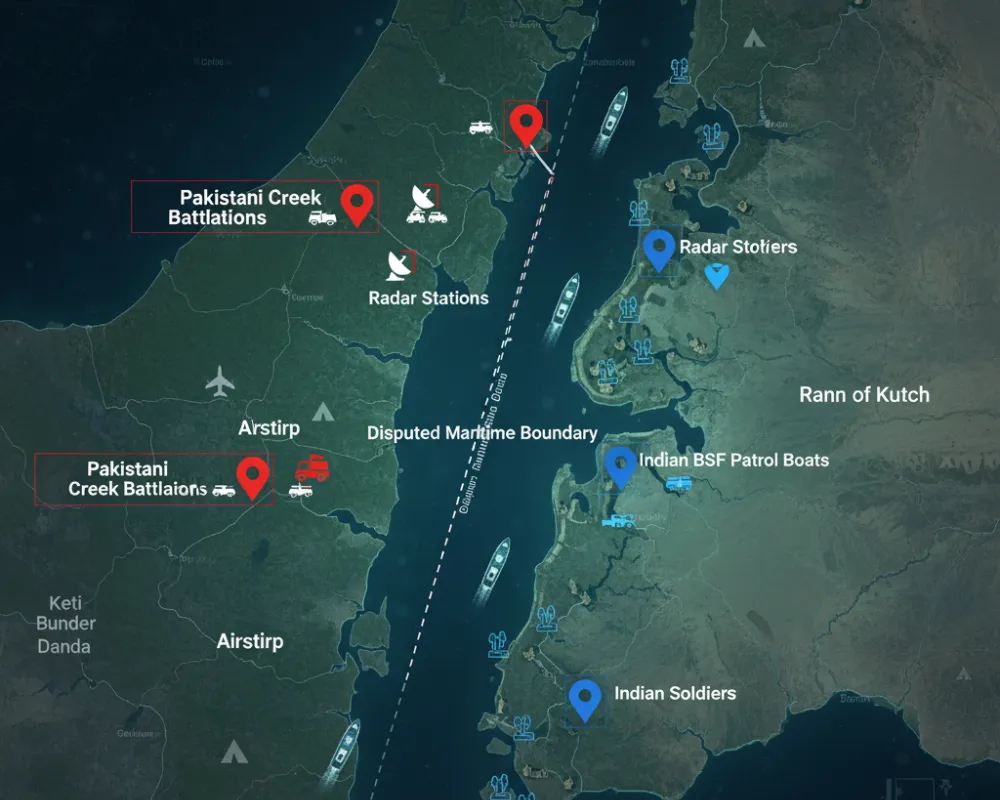Rajnath Singh warns Pakistan against Sir Creek aggression, citing military buildup. Dispute over 96 km estuary impacts fishing, oil, gas, and maritime boundaries.
 Brajesh Mishra
Brajesh Mishra

Defense Minister Rajnath Singh delivered a sharp warning to Pakistan on October 2, 2025, declaring that any military adventurism in the disputed Sir Creek region would provoke a “decisive response” strong enough to change “both history and geography.” His remarks came amid intelligence reports of Pakistan’s major military infrastructure expansion along the sensitive border.
What Happened:
During Dussehra celebrations at Bhuj Military Station in Gujarat, Rajnath Singh warned Pakistan against expanding its military presence near Sir Creek, stressing that any misadventure would meet with a historic response.
When & Where:
The statement was issued on October 2, 2025, during Shastra Puja (weapon worship) ceremonies in Bhuj, Gujarat. The Sir Creek region—a 96 km tidal estuary—lies between Gujarat’s Rann of Kutch and Pakistan’s Sindh province.
Who Was Involved:
Notable Quotes:
1. What is the Sir Creek dispute?
The Sir Creek dispute is a boundary disagreement between India and Pakistan over a 96 km tidal estuary in the Rann of Kutch, Gujarat. The issue stems from conflicting interpretations of a 1914 colonial-era resolution.
2. Why is Sir Creek strategically important?
Control of Sir Creek affects maritime boundary delimitation, Exclusive Economic Zones (EEZs), oil and gas exploration rights, and fishing grounds in the Arabian Sea. It also serves as a potential infiltration route for terrorists.
3. What did Rajnath Singh say about Pakistan’s buildup?
On October 2, 2025, Defense Minister Rajnath Singh warned that any Pakistani military misadventure in Sir Creek would provoke a decisive response capable of changing both history and geography. He also reminded Pakistan that “the route to Karachi passes through Sir Creek.”
4. What military buildup has Pakistan carried out in Sir Creek?
Pakistan has deployed six creek battalions of the Sindh Regiment, set up radars, air defense systems, surveillance aircraft (P-3 Orion), and emergency airstrips. Much of the infrastructure is based on Chinese technology.
5. How does the dispute affect fishermen?
Because the maritime boundary is undefined, fishermen from both countries often cross into disputed waters unknowingly. This leads to frequent arrests, detentions, and boat seizures, harming local livelihoods.
6. Has the Sir Creek issue been negotiated before?
Yes. India and Pakistan conducted joint surveys in 2005, but talks stalled. India supports the Thalweg Principle (mid-channel boundary), while Pakistan claims the entire creek.
7. How is China linked to the Sir Creek dispute?
Pakistan’s military buildup in the region heavily uses Chinese defense technology. Experts warn that China’s involvement complicates the dispute, adding a potential third-party dimension.
8. Could the Sir Creek conflict escalate into war?
Experts see Sir Creek as a flashpoint that could escalate if provoked. Rajnath Singh’s rhetoric linking the creek to Karachi’s security underscores India’s readiness to respond militarily if tensions rise.






Sign up for the Daily newsletter to get your biggest stories, handpicked for you each day.
 Trending Now! in last 24hrs
Trending Now! in last 24hrs